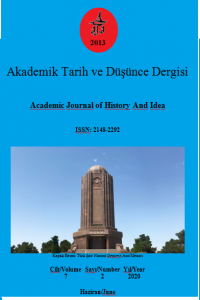Antik Yunan ve Roma Dünyasında Fizyonomi: Tarihsel Köken, Bakış Açısı ve Yöntem
Mezopotamya, Alamdimmu, Polemon, fizyonomi, gözler
Physiognomy In The Ancient Graeco-Roman World: Historical Origin, Perspective and Method
Mesopotamia, Alamdimmû, Polemon, physiognomy, eyes.,
___
- Referans1 BARTON, Tamsyn S., Power and Knowledge, Astrology, Physiognomics, and Medicine under the Roman Empire, University of Michigan Press, Michigan 1994.
- Referans2 BONFANTE, Larissa, “Etruscan Inscriptions and Etruscan Religion”, The Religion Of The Etruscans, (Edit Nancy Thomson de Grummond-Erika Simon), University of Texas Press, Austin 2006, s. 9-26.
- Referans3 BÖCK, Barbara, Die Babylonisch-assyrische Morphoskopie, Archiv für Orientforschung, Beiheft 27, Cambridge University Press, Viyana 2000.
- Referans4 BURKERT, Walter, The Orientalizing Revolution, Near Eastern Influence On Greek Culture In The Early Archaic Age, (çev. Margaret E. Pinder ve Walter Burkert), Harvard University Press, Londra 1992.
- Referans5 CALVERLEY, Charles Stuart, Theocritus, Translated into English Verse, Cambridge University Press, Cambridge 1869.
- Referans6 CHIAI, Gian Franco, “Good emperors, bad emperors: The function of of physiognomic representation in Suetonius’ De vita Caesarum and commonsense physiognomics”, Visualizing The Invisible With The Human Body, Physiognomy and Ekphrasis In The Ancient World, C. 10, (Edit J. Cale Johnson-Alessandro Stavru), De Gruyter, Berlin/Boston 2019, s. 203-226.
- Referans7 DAVIES, John, CREUZER, Georg Friedrich ve KAYSER, Carl Philipp, M. Tullii Ciceronis De Divinatione et De Fato, Frankfurt 1828.
- Referans8 DUYMUŞ FLORIOTI, H. Hande, “Eski Mezopotamya’da Kehanet Olgusuna Genel Bir Bakış”, Tarih Okulu Dergisi (TOD), Yıl 6, S. XV, 2013, s. 23-42.
- Referans9 ERHAT, Azra ve KADİR, A., Homeros İlyada, Can Yayınları, İstanbul 1993.
- Referans10 EYÜBOĞLU, Sabahattin ve CİMCOZ, M. Ali, Devlet, Platon, Hasan Âli Yücel Klasikler Dizisi, Türkiye İş Bankası Kültür Yayınları, İstanbul 2010.
- Referans11 FINKEL, Irving L., “Adad-apla-iddina, Esagil-kīn-apli, and the Series SA.GIG”, A Scientific Humanist Studies in Memory of Abraham Sachs, (Edit Erle Leichty-Maria de Jong Ellis-P. Gerardi), Occasional Publications of The Samuel Noah Kramer Fund 9, Philadelphia 1988, s. 143-159.
- Referans12 FOESTER, Richardus, Scriptores Physiognomonici Graeci et Latini, C. I-II, Leipzig 1893.
- Referans13 GELLER, Markham J., “The Exorcist’s Manual (KAR 44)”, Assyrian and Babylonian Scholarly Text Catalogues: Medicine, Magic, and Divination, (Edit Ulrike Steinerts), De Gruyter, Berlin/Boston 2018, s. 292-312.
- Referans14 GOTTLOB KÜHN, D. Carolus, Claudii Galeni Opera Omnia, C. XI, Leipzig 1826.
- Referans15 HARTSOCK, Chad, Sight and Blindness in Luke-Acts, The Use of Physical Features In Characterization, Biblical Interpretation Series, (Edit R. Alan Culpepper-Ellen van Wolde), C. 94, Brill, Boston 2008.
- Referans16 KINNIER WILSON, J. V., “The Nimrud Catalogue of Medical and Physiognomical Omina” Iraq, C. 24, S. 1, Cambridge 1962, s. 52-62.
- Referans17 KINNIER WILSON, J. V., “Two Medical Texts from Nimrud” Iraq, C. 18, S. 2, Cambridge 1956, s. 130-146.
- Referans18 LEUNISSEN, Mariska, “Physiognomy”, Oxford Handbook of Science and Medicine in the Classical World, (Edit Paul Turquand Keyser-John Scarborough), Oxford University Press, Oxford 2018, s. 742-764.
- Referans19 LLOYD-JONES, Hugh, Females of The Species, Semonides on Women, Noyes Press, İngiltere 1975.
- Referans20 MARSHALL, Peter Kenneth, A. Gellii – Noctes Atticae, Tomus I, Libri I-X, Oxonii, Oxford 1968.
- Referans21 MAUL, Stefan M., “Divination Culture and the Handling of the Future”, The Babylonian World (Edit G. Leick), Routledge, New York/Londra 2007, s. 361-372.
- Referans22 MISENER, Geneva, “Loxus, Physician and Physiognomist”, Classical Philology, C. XVIII, Chicago 1923, s. 1-22.
- Referans23 PINGREE, David Edwin, “Mesopotamian Omens in Sanskrit”, La circulation des biens, des personnes, et des idées dans la proche-orient ancient, (Edit D. Charpin-F. Joannès), ERC Press, Paris 1992, s. 375-379.
- Referans24 POPOVIĆ, Mladen, Reading the Human Body, Physiognomics and Astrology in the Dead Sea Scrolls and Hellenistic-Early Roman Period Judaism, Brill, Leiden 2007.
- Referans25 REPATH, Ian, “The Physiognomy of Adamantius the Sophist”, Seeing The Face, Seeing The Soul; Polemon’s Physiognomy from Classical Antiquity to Medieval Islam, (Edit S. Swain), Oxford University Press, Oxford 2007, s. 486-547.
- Referans26 REPATH, Ian, “Anonymus Latinus, Book of Physiognomy”, Seeing The Face, Seeing The Soul; Polemon’s Physiognomy from Classical Antiquity to Medieval Islam, (Edit S. Swain), Oxford University Press, Oxford 2007, s. 548-635.
- Referans27 SCHMIDTCHEN, Eric, “Esagil-kīn-apli’s Catalogue of Sakikkû and Alamdimmû”, Assyrian and Babylonian Scholarly Text Catalogues, Medicine, Magic and Divination, C. 9, (Edit Ulrike Steinert), De Gruyter, Boston/Berlin 2018, s. 137-157.
- Referans28 SCHMIDTCHEN, Eric, “The series Šumma Ea liballiṭka revisited”, Visualizing The Invisible With The Human Body, Physiognomy and Ekphrasis In The Ancient World, C. 10, (Edit J. Cale Johnson-Alessandro Stavru), De Gruyter, Berlin/Boston 2019, s. 81-118.
- Referans29 SOMMERSTEIN, Alan H., The Comedies of Aristophanes, Clouds, C. 3, Warminster: Aris&Phillips, İngiltere 1982.
- Referans30 SOMMERSTEIN, Alan H., The Comedies of Aristophanes, Lysistrata, C. 7, Warminster: Aris&Phillips, İngiltere 1990.
- Referans31 ŞENTUNA, Candan, Diogenes Laertios – Ünlü Filozofların Yaşamları ve Öğretileri, Yapı Kredi Yayınları, İstanbul 2007.
- Referans32 WILLIAMS, Steven J., The Secret of Secrets, The Scholarly Career of a Pseudo-Aristotelian Text in the Latin Middle Ages, University of Michigan Press, Michigan 2003.
- Referans33 ZYSK, Kenneth, “Mesopotamian and Indian physiognomy”, Visualizing The Invisible With The Human Body, Physiognomy and Ekphrasis In The Ancient World, C. 10, (Edit J. Cale Johnson-Alessandro Stavru), De Gruyter, Berlin/Boston 2019, s. 41-60.
- Yayın Aralığı: Yılda 6 Sayı
- Başlangıç: 2013
- Yayıncı: Hakan YILMAZ
Sabir Yaradiciliğinda Təxmis və Təsdis: Poetik Özəllikləri və Struktur Xüsusiyyətləri
Türklerde Bayrağın Ölüm ve Yas Alameti Olarak Kullanılması
Temuçin FAİK ERTAN, Bahattn DEMİRTAŞ
Amerika romanının əsas inkişaf mərhələləri haqqında (XX əsrin birinci yarısı)
Türkiye-İsrail İkili İlişkileri ve 1958 Antlaşması
Uygur Harfli Oğuznamedeki Hayvanlarla Oğuz Kağan’ın İlişkisi
Slav Kültüründe Bazı İnanış ve Törenlerde Kırmızı Renk
Amerika ədəbiyyatinda detektiv janrin əsas ideoloji aspektləri
Köy Enstitüleri ve Orkun Dergisinin Köy Enstitülerine Yaklaşımı
Nahçıvan Özerk Cumhuriyetinde Tarımın Durumu (1991-2016 yılları)
